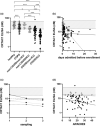Decreased plasma cartilage acidic protein 1 in COVID-19
- PMID: 37667413
- PMCID: PMC10477339
- DOI: 10.14814/phy2.15814
Decreased plasma cartilage acidic protein 1 in COVID-19
Abstract
Cartilage acidic protein-1 (CRTAC1) is produced by several cell types, including Type 2 alveolar epithelial (T2AE) cells that are targeted by SARS-CoV2. Plasma CRTAC1 is known based on proteomic surveys to be low in patients with severe COVID-19. Using an ELISA, we found that patients treated for COVID-19 in an ICU almost uniformly had plasma concentrations of CRTAC1 below those of healthy controls. Magnitude of decrease in CRTAC1 distinguished COVID-19 from other causes of acute respiratory decompensation and correlated with established metrics of COVID-19 severity. CRTAC1 concentrations below those of controls were found in some patients a year after hospitalization with COVID-19, long COVID after less severe COVID-19, or chronic obstructive pulmonary disease. Decreases in CRTAC1 in severe COVID-19 correlated (r = 0.37, p = 0.0001) with decreases in CFP (properdin), which interacts with CRTAC1. Thus, decreases of CRTAC1 associated with severe COVID-19 may result from loss of production by T2AE cells or co-depletion with CFP. Determination of significance of and reasons behind decreased CRTAC1 concentration in a subset of patients with long COVID will require analysis of roles of preexisting lung disease, impact of prior acute COVID-19, age, and other confounding variables in a larger number of patients.
Keywords: CFP/properdin; COVID-19; CRTAC1; Type 2 alveolar epithelial cells.
© 2023 The Authors. Physiological Reports published by Wiley Periodicals LLC on behalf of The Physiological Society and the American Physiological Society.
Figures





References
-
- Anjos, L. , Morgado, I. , Guerreiro, M. , Cardoso, J. C. , Melo, E. P. , & Power, D. M. (2017). Cartilage acidic protein 1, a new member of the beta‐propeller protein family with amyloid propensity. Proteins, 85, 242–255. - PubMed
-
- Ballard, P. L. , Lee, J. W. , Fang, X. , Chapin, C. , Allen, L. , Segal, M. R. , Fischer, H. , Illek, B. , Gonzales, L. W. , Kolla, V. , & Matthay, M. A. (2010). Regulated gene expression in cultured type II cells of adult human lung. American Journal of Physiology. Lung Cellular and Molecular Physiology, 299, L36–L50. - PMC - PubMed
-
- Benjamini, Y. , & Hochberg, Y. (1995). Controlling the false discovery rate: A practical and powerful apporach to multiple testing. Journal of the Royal Statistical Society: Series B, 57, 289–300.
Publication types
MeSH terms
Substances
Grants and funding
LinkOut - more resources
Full Text Sources
Medical
Research Materials
Miscellaneous

